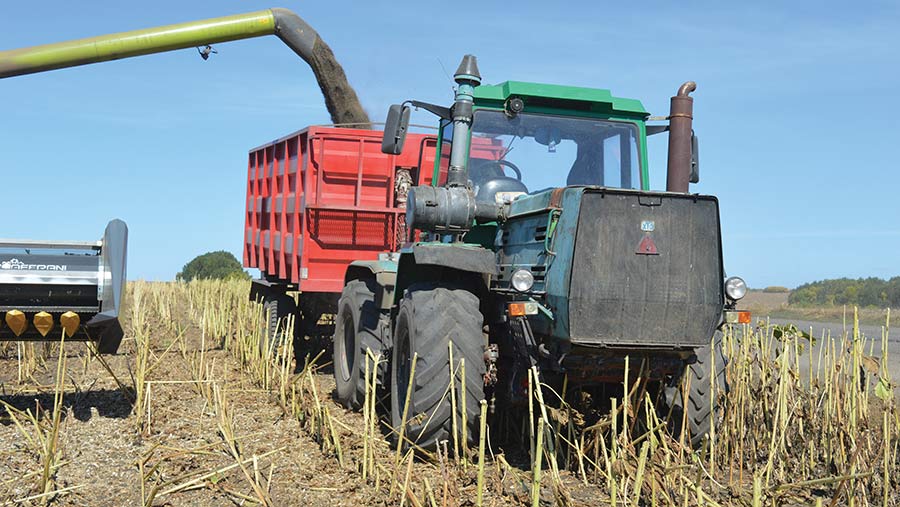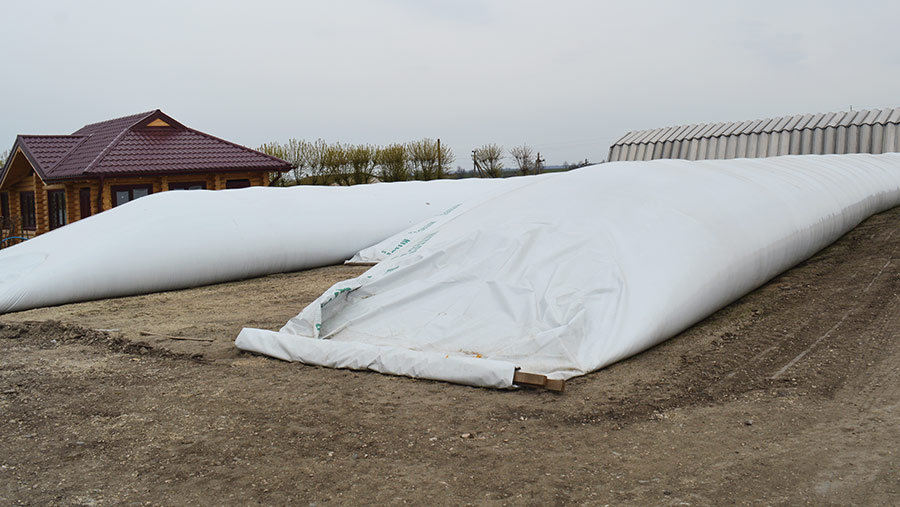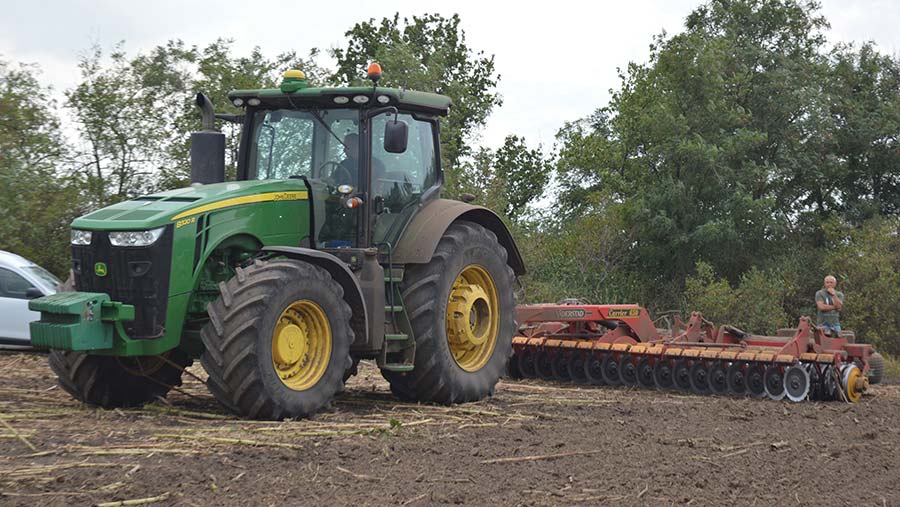Farming in Ukraine: Q&A with agricultural journalist in the war zone
 © Ihor Pavliuk
© Ihor Pavliuk The Russian invasion of Ukraine on 24 February had repercussions across the globe, but few are experiencing the consequences quite as acutely as the hundreds of thousands of farmers valiantly to produce crops.
In this Q&A, Ihor Pavliuk explains the story on the ground – the trials, tribulations and challenges, and how enterprising, stoic farmers are overcoming them.
See also: Laverda dealer finds exotic homes for old combines
About the author

Ihor Pavliuk is an agricultural journalist based in the Cherkaska region of central Ukraine, south of Kyiv. He explains how farming has changed since the Russian invasion, the challenges of keeping machinery running, and his expectations for the coming year.
How much land is out of action?
Nasa puts it at 22% of the 42.7m hectares, so roughly 10m hectares. This includes occupied territories and land in the war zone.
When the invaders fled from the north of Ukraine in April, mines and shells also remained in the fields. It’s impossible to clear everything in a short time over an area of many thousands of miles.
Farmers were in a hurry to sow grain in the spring, so tractors and trucks exploded virtually every day.
The problem has not disappeared now – just a few days ago, a farmer from the Sumy region died while driving a truck full of grain.
How much lower will this year’s harvest be?
It is difficult to say. According to official figures, 16m tonnes of wheat was harvested across the territory of Ukraine free from Russians.
By comparison, last year’s crop throughout the entire territory was around 30m tonnes of wheat, plus 5m tonnes of barley and 2.8m tonnes of rapeseed.
The average wheat yield is 4t/ha but, due to weather conditions and the inability to apply fertiliser and pesticides on time, that will probably be 10-15% lower.
Drought has been a problem too, with maize crops failing to form grain in many regions.
What about livestock farmers?
The livestock sector has shrunk by about 15%. That said, it wasn’t considered a profitable industry before the war and had been in decline for several years.
In free regions more than 50km from the front line, it is safe to transport milk and any other goods.
But it’s a strange feeling that your life, and that of your children, is being decided just a few hours away from your home.
Has the war effort caused a labour shortage?
Reliable machine operators were already in short supply, and now many of them have gone to the front.
As far as I understand, they are trying to draft fewer tractor and combine operators into the army so that there are enough people to work in the field and drive farm machinery.
How about access to seed and fertiliser?
It is surprisingly normal. Seed for the dominant crop types, both national and world brands, are produced in Ukraine, but there is also some coming in from abroad.
Fertiliser is now very expensive. Saltpeter (potassium nitrate) costs 30,000-33,000 hryvnias/t (£685-£755/t) – triple that of a year or two ago.
Therefore, many farmers will not use any fertiliser, and the rest are likely to cut back drastically.
If it remains difficult to sell grain abroad and farmers have to rely on the domestic market, where they are offered ridiculously low prices of £50-£65/t, then as much as one-quarter of the arable area will likely go unsown next year.
Are farmers trying to increase their grain storage capacity?
Yes, almost all farmers are looking for ways to solve the export issue. They are cleaning, disinfecting and renovating old warehouses, and even abandoned livestock farms.
Those who have money have built inexpensive metal hangars.
Polyethylene sleeves for grain storage are in great demand, too. I think there is the capacity to store what is left from last year and the new crop.
That said, part of the area under maize will remain unharvested due to the fact that the price of natural gas is unrealistically high and it will be unprofitable to cut, dry and store it.

Grain bags provide extra storage for Ukrainian farmers © Ihor Pavliuk
What are diesel supplies like?
The first thing people did in the early hours of the war on 24 February was fill up their cars and spare cans at gas stations.
But a serious shortage of fuel began in early April, when Russian rockets hit an oil refinery in Kremenchuk – it was the only plant working at that time.
That led to big problems and I had to stand for six hours to get just 20 litres, though the stations were resupplied every few days.
Some farmers bought diesel in advance at a wholesale price, and this saved them. However, the rest had to either stop work and wait, or buy fuel at crazy prices.
Before the war, a litre of diesel at a gas station cost 26 hryvnias (59p), and farmers bought it cheaper wholesale.
During the period of shortage, speculators demanded 62-80 hryvnia/litre (£1.42-£1.83/litre), sometimes even up to 100 hryvnia (£2.29).
Now the price has stabilised at about 52 hryvnia (£1.19) and it’s possible to buy diesel without any problems.
What about spare parts?
Logistics were immediately disrupted, and most farmers were unable to get the spare parts they had ordered. Some of my farming friends bought everything in dealers’ warehouses – even parts they didn’t need.
This situation lasted until about mid-April, but it’s almost back to normal now.
Do machinery dealers have a stock of equipment to sell?
In the first months of war, dealers could only sell equipment that had already been imported into Ukraine. Many farmers failed to receive the kit they had ordered and paid for, partly due to the Russian seizures of ports.
This has now changed in some areas, where dealers are not only importing new machinery, but even presenting new models and brands.
How many tractors are sold annually?
The numbers vary. In 2018, it was more than 3,000, but just 2,109 in 2019. In 2020, that dropped to less than 2,000, but the market grew by 79% last year – with at least 3,000 tractors sold.
How do you expect this to change over the next few years?
It all depends on how many years the war lasts and whether the Ukrainian army will be able to liberate the southern territories and the seaports from which grain is exported.
If this does not happen, up to 25% of the fields will remain unsown. Why drill wheat if you have 10,000t of unsold grain in stock?
The main problem is that many farmers have run out of money. The state allocates loans, but they are difficult to obtain.
If the situation does not change then no one will buy imported equipment – even if you have money in the bank, you are unlikely to invest it in a business that does not bring any profit.
However, almost all farmers will sow food crops in order to feed the population of Ukraine.
These include wheat, peas, buckwheat and sugar beet, which was considered an unprofitable and problematic crop but now brings the highest profitability. Sugar is hard currency.
What are the most popular machinery brands?
Wealthy farmers buy equipment from the world’s best manufacturers – John Deere, Case IH, New Holland, Claas, Massey Ferguson and Fendt.
Before the war, Belarusian MTZ tractors accounted for a large segment of sales, as they are cheap and easy to repair. Now I expect MTZ to disappear from the Ukrainian market, for obvious reasons.
In addition, inexpensive 200-300hp Ukrainian HTZ tractors are produced in Kharkiv. But the city is shelled every day, and I don’t know if tractors will be produced there any longer.
Chinese tractors, such as YTO, are becoming increasingly popular among small farmers. They cost almost the same as the Belarusian MTZ, but have a wider range of options.

John Deere remains a popular brand in Ukraine © Ihor Pavliuk
Are Ukrainian firms still manufacturing farm machinery?
Over the past eight years, Ukrainian manufacturers managed to seriously improve the quality and range of products they offer.
This was helped by a government compensation scheme that contributed to the cost of purchasing domestically produced agricultural machinery, which was upped from 25% to 40%.
Manufacturers of elevator equipment – such as Lubnymash, KMZ and Yug-Elevator – are almost as good as established global brands, but are far cheaper.
The same can be said of drills, cultivators, combine headers and trailers.
The problem is that some manufacturers remained in the occupied territory, such as John Greaves – a maker of quality combine headers in Berdyansk on the Sea of Azov.
What about the army vehicles that farmers have captured from the Russians?
Most of the tanks and armoured personnel carriers taken from the invaders were given to the Ukrainian army for repairs. But I’m sure some farmers have hidden the tanks to show their grandchildren in years to come.

